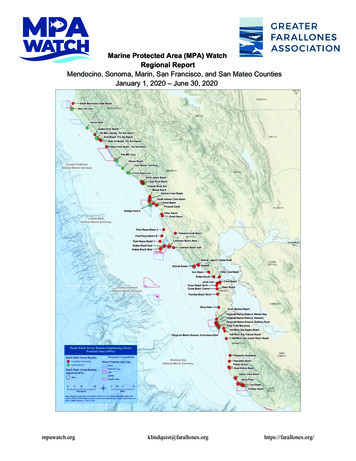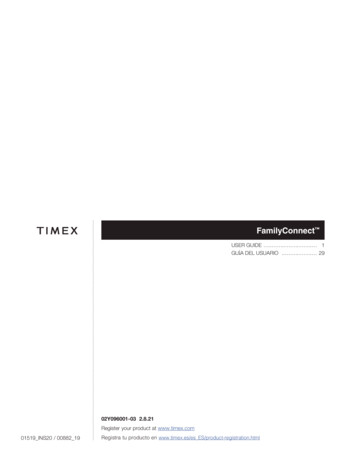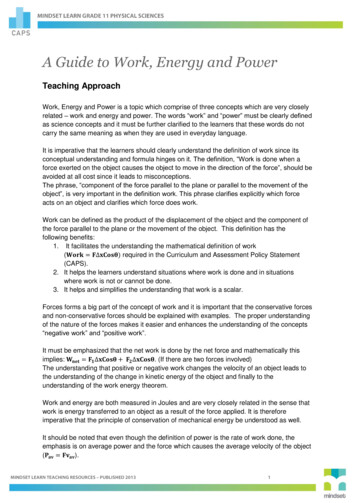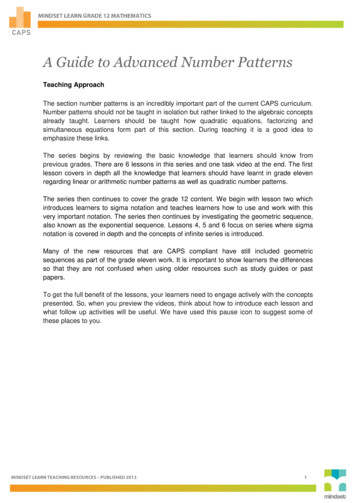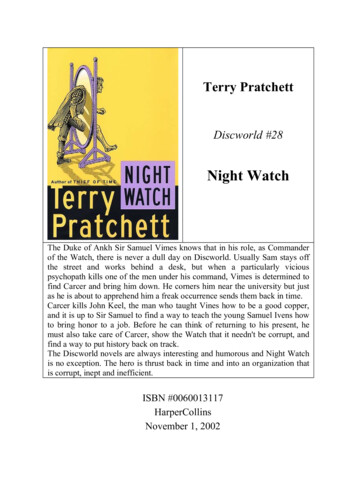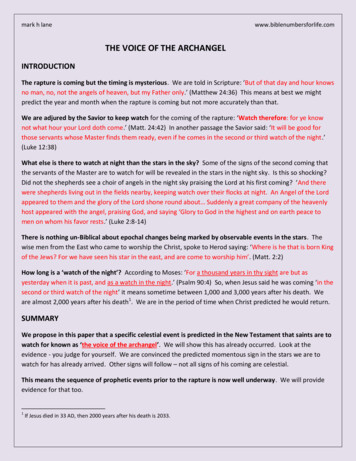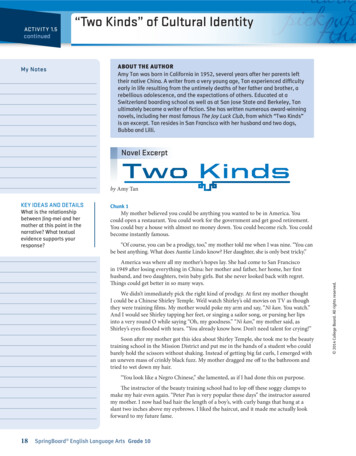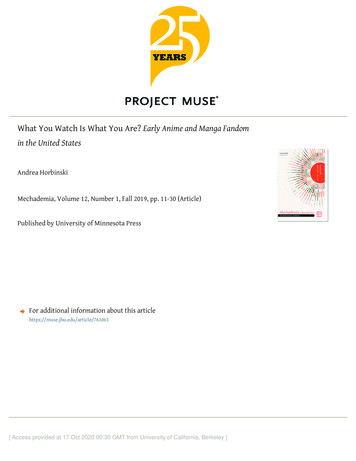
Transcription
What You Watch Is What You Are? Early Anime and Manga Fandomin the United StatesAndrea HorbinskiMechademia, Volume 12, Number 1, Fall 2019, pp. 11-30 (Article)Published by University of Minnesota PressFor additional information about this articlehttps://muse.jhu.edu/article/761063[ Access provided at 17 Oct 2020 00:30 GMT from University of California, Berkeley ]
What You Watch Is What You Are?Early Anime and Manga Fandom in the United StatesANDREA HORBINSKIThe early years of anime and manga fandom in the United States were anera in which a fascinating welter of developments occurred simultaneouslyamong fans of “geeky” popular culture, particularly science fiction, comics,and gaming, and set the stage for the current structures of fandom as theyexist today. Over the course of approximately twenty years in the 1970s and1980s, American fans attracted to “Japanimation” came to identify themselvesas anime fans, a process that was by no means guaranteed to end with thatresult. Indeed, in their first few decades in the United States both anime andmanga went through processes of familiarization, estrangement, and readoption that mirrored the experience of other new media in other timesand places, particularly that of movies in Japan in the 1900s through 1920s.The evolution of American fans’ attitudes toward these media was closelyrelated to the fates of the first companies’ attempts to operate for profit inthese spaces, and the failures of these companies’ efforts to import animeand manga as cartoons and comics essentially conditioned the current regimeamong both companies and fans that celebrates anime and manga as distinctly Japanese media.Sociologist Casey Brienza contends that the history of manga publication in the United States before the start of the period she covers in Manga inAmerica is more or less irrelevant because “manga was simply not, in short,something that was ever going to work in the comics publishing field” andtherefore is not worth discussing at length.1 While these conclusions arecertainly correct for Brienza’s study of the American manga industry since1997, as a historian I cannot agree that those prior decades ought to be disregarded. Failure structures later developments no less than success, and thefailures of anime and manga tell a story that is worth adding to the largernarrative of popular culture and its audiences in these decades. Moreover,taking a bottom-up rather than top-down vantage point on this era tells avery different story than the one we can derive from corporate sources; fancultures are driven by motives other than pure profit, and the archives of fan11
12ANDREA HORBINSKIcultures reveal that even in the years when Japanese media were not sellingwell, fans were still engaging with them in ways that were consequential. Inother words, telling the story of popular culture without engaging with theaudiences who consume it creates a fundamentally one- sided and inaccuratenarrative.First, We Take California: Anime ArrivesEarly anime fans were drawn to anime not because it was Japanese but because it was an additional form of science fiction or cartoons, in which theyhad a prior interest. In this respect, the experience of Fred Patten (1940– 2018), who had grown up watching cartoons on television and who eventually became a notable figure in science fiction, anime and manga, and furryfandoms, was more or less representative. Living in southern California hisentire life, Fred became one of the founders in 1977 of what was christened the“Cartoon/Fantasy Organization” (C/FO), which is now regarded as America’sfirst anime club, eventually serving as its secretary after the organizationexpanded nationally.2 The archives of the Fred Patten Collection in the EatonLibrary of Science Fiction at the University of California, Riverside, on whichthis paper principally draws, are full of proof and final copies of Fred’s desktop publishing efforts in service of the C/FO and other associated fan events,including science fiction and anime conventions, over the course of more thanforty years.Patten was himself a furry, which may explain the choice of “Sandy,” ananthropomorphized female otter- type creature with antennae who served asthe group’s mascot despite the fact that she had no clear analog in the animethat was one of the group’s mainstays. Although Patten later emphasized theC/FO as an anime club, materials in the archives make clear that not every C/FO member nationwide shared this evaluation: Patten himself complainedin a report on a trip to Japan in 1986 that the anime goods shops he and hisgroup visited did not contain a lot of “cute animal” merchandise— “cute animals” being the code for characters that drew furry attention used throughmost of the Patten materials. While cat and bunny girls are certainly not unknown in anime and manga and video games, they were perhaps somewhatless common in the 1980s than they have become in the age of Final Fantasyand the JRPG. In any case, there is quite a difference between the style ofanimalization of the human form epitomized by Fran from Final Fantasy XII
WHAT YOU WATCH IS WHAT YOU ARE?13Figure 1. 1983 C/FO newsletter for the Los Angeles and Orange County chaptersshowing Sandy on the masthead.and, say, Minnie Mouse or Lola Bunny, who epitomized the American style ofanthropomorphization of the animal form that future furries tended to encounter in cartoon consumption from childhood onward in the United States.The C/FO started in Los Angeles and spread from there to Orange Countyand the Inland Empire and eventually to other states. Chapters met in a variety of rental spaces, including nerd- related bookstores or game shops, andwatched programs of cartoons for several hours on a regular, usually monthly,
14ANDREA HORBINSKIbasis. New chapters in other areas were usually started by people who hadattended a few meetings of an established chapter and were inspired to replicate the experience closer to home. Chapter members paid membershipfees to cover costs, and chapters themselves paid an annual fee to the C/FOparent organization, run out of Patten’s apartment, to maintain their officialstatus. Screening attendees were usually asked to contribute an admission feeat each meeting to cover costs related to the use of the space or the distribution of the programs for the meeting’s content, which were usually the solemeans of knowing anything about what was being shown in this pre- internetage. Nonmembers paid a surcharge for newsletters and programs in somechapters, incentivizing them to become full- fledged members. In the case ofanime, the programs reveal some fascinating commonalities in the way thatfans took it upon themselves to wrestle this content into a format they couldunderstand and enjoy.In the 1970s and 1980s anime was mostly available in the United Statesin two ways. The first, much less common, way was as a dubbed and adaptedversion of the show that was broadcast in English on U.S. television stationsand that frequently bore little if any relation to the original. (Ironically, theEnglish- language adaptation of Tetsuwan Atomu [1963– 66, Astro Boy], whichset the paradigm for this first age of anime adaptations, may have been oneof the most faithful of them all.) As the 1980s went on, C/FO members alsoreported that anime was broadcast with subtitles in some markets; this wasthe case with Galaxy Express 999 (1978– 81, Ginga tetsudô 999) in the New YorkCity area, for example. Second, and much more regularly, however, fans werewatching pirated copies of anime that had been recorded from televisionsdirectly onto VHS, usually by people who had access to Japanese- languagetelevision channels, primarily in California and Hawai’i, or by members ofthe U.S. armed forces or their families who were stationed in Japan. A thrivingtrade in copies of these VHS tapes, sustained by informal networks amongfans and occasionally being sold for profit at game or comics shops and conventions, meant that quality was highly variable (since VHS tape, being physical and magnetic, degrades with each copy made) and that it was sometimesdifficult to secure sequential runs of episodes of the same shows.The central problem of early anime fandom was that very few peoplespoke Japanese. With shows that were dubbed and officially distributed inEnglish vastly outnumbered by those that were not (and in an environmentin which local TV stations dropped shows with low ratings mercilessly, frequently leaving devoted viewers with no officially licensed alternatives to see
WHAT YOU WATCH IS WHAT YOU ARE?15Figure 2. March 1989 map prepared for the C/FO newsletter depicting known animeclubs across the United States and Canada.the rest of a cancelled series), early anime fans in the United States evolveda number of strategies to mitigate the difficulties of the language barrier.As attested in the Patten archive, these strategies took four principal forms:episode synopses, episode transcripts, Japanese vocabulary building, and livesummary and/or translation of shows.Of these, the first two forms were by far the most common, judging bythe preponderance of surviving documents related to them in the Patten archives. Episode synopses were generally written by diligent fans with insider knowledge, whether this took the form of Japanese language skills oraccess to officially available promotional materials, which Fred Patten, forexample, often obtained through his role as a freelance writer/promoter forJapanese animation studios and their shows in the California market andnationally.3 These synopses were then typed up and photocopied for distribution, either through newsletter mailing networks or their sale at animescreenings. Someone could purchase a set of synopses in order to watch awhole show and know what was going on, or to fill in the gaps in their knowledge of the show if they had not managed to obtain all of the episodes. The feescharged for these synopses were deliberately nominal, usually just enough torecoup printing and shipping costs (if applicable); the belief that being “noncommercial” is a legitimate defense against potential copyright infringement
16ANDREA HORBINSKIclaims was already strong in fandom spaces, and it remains so in some areasof fandom to this day.4Episode synopses, however, were deliberately somewhat high- level, designed to convey the events of an entire show of 26, 39, or 52 or more episodesin a manageable amount of paper and text. Episode transcripts were the strategy of choice for those who wanted to know what was happening in a givenepisode of anime on the most granular level possible. Given the level of effortinvolved in translating every line in a twenty- two- minute episode, completewith descriptions of actions and events, and then typing up all that text, itis perhaps unsurprising that full- blown episode transcripts are relativelyuncommon in the Patten archive. Those that were archived usually have aprice of 1 per copy, one episode each. More interesting, almost all of them include pages with explanations that insist the transcript is an “interpretation,”which does not infringe on the Japanese copyright holders in any way; all ofthem, however, appear to be unvarnished translations, which does constitutecopyright infringement under U.S. law.The fannish attitude toward the rights holders and the companies involved in officially licensing and distributing anime in the United States at thetime was an outgrowth of the deferential posture evidenced in these notes— notwithstanding the fact that most of the anime fans consumed was piratedin one way or another. American anime fans generally saw themselves asboosters of anime in their local broadcast markets, and they aspired to officialacknowledgment of their activities in their roles as early adopters, which theyactually achieved to some degree in the late 1970s. As Fred Patten related in a2001 book chapter, years of contact between the C/FO in Southern Californiaand Japanese anime studios began with a visit from Tezuka himself to a C/FO meeting in 1978. This meeting culminated in “a tour group of about thirtyJapanese cartoonists and animators,” including Tezuka, who attended the SanDiego Comic Con (SDCC) in 1980, “so they could see for themselves what anaudience Japanese animation was developing in the United States.” Althoughnothing much came of this tour at the institutional level, according to Patten,“the influence on the fledgling anime fans of having met some of the mostpopular Japanese cartoonists, and the concept that fans were performing animportant cultural service by helping to introduce Japanese animation toAmericans, had a significant effect for years.”5But the influence in this era was not all one way. In a fine irony, the visitof (future) Japanese anime industry figures to American fandom in 1980 thatwas to have a lasting impact on Japanese fan cultures as a whole was not that
WHAT YOU WATCH IS WHAT YOU ARE?17of Tezuka and company to SDCC. Rather, it was that of Okada Toshio (b. 1958)and Takeda Yasuhiro (b. 1957) to the science fiction convention Worldcon inBoston (specifically, Noreascon Two), which directly inspired their bid to hostthe now- legendary DaiCon III convention in Osaka in 1981 and launched themon the path to founding General Products and Gainax. Unheralded, unanticipated, and unknown as Okada and Takeda were (the exact opposite of thedeference shown to Tezuka and his colleagues in San Diego), their Worldconexperience ultimately changed fandom worldwide in another example of thetransnational influence of fannish border- crossing.6Languages and Letters: Speaking for AnimeThe deference shown toward rights- holders in the fannish newsletters wasthe flip side of an argument that would eventually bring down the C/FO asa national organization and reconfigure the U.S. anime fandom scene by thebeginning of the 1990s, namely, the ongoing argument about pirated versusofficially distributed media and what moral obligation fans had to media companies, if any. The arguments about piracy were and are partly a consequenceof an exaggerated idea of the importance of what was a small minority ofearly adopters to the commercial potential of officially licensed media.7 In the1970s and 1980s, however, this attitude most often manifested in campaigns toeither reverse a cancellation decision or to get a local TV station to put animeon the air.Letter- writing campaigns had been pioneered in the science fictionfandom community in the late 1960s, when Bjo Trimble (b. 1933), assistedby her husband John, spearheaded the grassroots letter- writing campaignthat successfully resulted in the production of the third season of Star Trek(1966– 69), reversing CBS’s decision to cancel the series after just two seasons.Judging by the contents of the Patten archive, anime campaigns had a mixedrecord. For example, the June 1982 bulletin of the C/FO– New York chapterinforms fans of the impending cancellation of the Galaxy Express 999 animein that market:As some of you know, Entel Communications has now started itsprogramming at 10:00pm Sundays, instead of 9:00pm. C/FOer PatriciaMalone has discovered that Galaxy Express 999 will go off the air thisweek and there is no planned replacement animation. The people at
18ANDREA HORBINSKIEntel feel that “not many ‘children’ are up at 10:00pm Sunday evening,”hence no sponsors.Naomi Saraki, the person who does the subtitles, believes that ifshe can get enough letters from people to show the higher- ups there isan audience, perhaps something could be done. We’ve asked this oncebefore; if everyone would please write to Entel, perhaps we could getthem to reinstate animation in their programming.As it happens, this particular C/FO- New York campaign was a success. TheAugust 1982 bulletin contained an update, informing fans: “In September,Mater & Tetsuro will be back from vacation to continue their trips on theGalaxy Express 999. Many thanks to everyone who wrote in and helped to getGE 999 back on the air. The people at ENTEL now know that their animationappeals to more than just kids.” Six months later, in the newsletter for the32nd monthly screening, the C/FO– New York was at it again, asking members to write to the local station WQR- TV9 on behalf of Fuji Television, whichwas “planning to introduce Reiji [sic] (Captain Harlock, Galaxy Express 999)Matsumoto’s animated series, ‘Queen of a Thousand Years,’ to american [sic]audiences. It is being translated into English and because it is not a violence- oriented series, it will survive the transition nearly intact.” The C/FO– NewYork cast this campaign in terms of mutual self- interest, saying that “Fujiwill need support from the US fans to get this series on television. . . . Onlyletters will work; lots of letters. They need proof that there is an audience forthe program. So, if you want some serious & intelligent animation on networkTV, write.”Letter- writing campaigns were by no means guaranteed to be successful,and a flyer entitled “Star Blazers in New York” from around the same time asthese C/FO– New York bulletins provides some hints as to why that could be.After outlining the current outlook in New York City for the broadcast of StarBlazers (1979– 84), the now- infamous English- language adaptation of threesliced and diced Space Battleship Yamato shows (1974, 1978, 1989, Uchû senkanYamato), the flyer detailed seven guidelines for fan letter writers, includingnot to call the TV station directly, not to write form letters, to mention theirage and request a later time slot for the show, to be polite (“Rude letters get usno place, and will hinder more than help”), to “mention that you have friendswho have also seen the show and enjoyed it. But try not to mention that youare part of a letter writing campaign that is organized,” not to write cut- and-
WHAT YOU WATCH IS WHAT YOU ARE?19Figure 3. “Japanese 001,” translated by Eddie Wood, circulated by the C/FO– New Yorkin its December 1983 newsletter.paste type letters on the grounds that “this will set us back, and will givethe impression that we are just a bunch of little kids,” and not to “get overinvolved with one letter. Your letter should be short and to the point.” At theend of the flyer, there is an address to which fans could send a self- addressedstamped envelope if they wanted to join the local Star Blazers fan club.The third strategy available to anime fans was studying Japanese, which,judging from the newsletters, usually took the form of guides to catchphrases
20ANDREA HORBINSKIand/or common expressions likely to recur in a given series or across animein general. This strategy also seems to have been relatively uncommon; itwas not until the 1990s and 2000s that college- level Japanese teachers in theUnited States began reporting that anime and manga were driving enrollments in Japanese- language classes. One example of such a guide containsbrush- painted reproductions of kanji and hiragana phrases used in television, specifically those for “the end” and “to be continued,” as well as explanations of the radicals in the kanji themselves. Another vocabulary listcirculated by the C/FO– New York in December 1983, including such commonwords and phrases as “gambatte” (defined literally as “Try hard!” or “Go forit!”), “hoshi” (usually “star,” sometimes “planet”), was defined in terms of theGalaxy Express 999 anime. Its definition of “Isoide” reads: “‘Hurry!’ 999 is pulling out of the station, Maytel & Tetsuro are running to catch it, the Conductorleans out the window, ‘Isoide! Hayaku!’”The fourth strategy of which anime fans availed themselves was by far themost interesting, namely that of live summary/translation at anime screenings. For whatever reason, this strategy, called “narration” in the newsletters, seems to have been practiced principally by the fans of the C/FO– NewYork, which began in 1980.8 In “narration,” bilingual fans, usually women,would live translate/interpret the anime for the benefit of their fellow non- Japanese- speaking fans. The undated newsletter that announced the 53rdmonthly screening of the C/FO– New York chapter, for example, states thatat the previous screening (presumably January 1985, given the reference toDisney’s The Black Cauldron [1985] as “upcoming”) chapter president Patricia“Pat” Malone “narrated the Macross episode, #36, which was given a wealth ofapplause when it ended.”Other C/FO– New York newsletters, however, betray the enormousamount of effort that these fan volunteers put into the screenings and thetensions that arose. In a letter published in the July 1983 bulletin and datedJune 20 of that year, Pat Malone registered her discontent with her fellow fansalong several axes, opening with the question, “How come people always askfor something in English but as soon as it’s shown some people are grumblingabout it and, as what happened last meeting, have it pulled for some Japanesecartoons.” Malone’s question was apparently prompted by a failed attemptto screen the animated feature Winds of Change (1979, Hoshi no Orufeusu) theprevious month; after twenty minutes, popular demand at the screening ledto turning off the movie and switching to anime. “We are the CARTOON FANTASY ORGANIZATION not the Japanese Cartoon Fan Association,” Malonewrote. “We are not exclusively Japanese cartoons many of us want to see
WHAT YOU WATCH IS WHAT YOU ARE?21something else, something different. Some people have gotten to be like thecensorship we all complain about, only it’s ‘if it isn’t Japanese, it’s no good.’”Malone had put a significant amount of personal labor into the club, asshe reminded people: “I have worked hard to get the club a meeting place, toget various and new programs. Also to get translations of programs. (I gavea narration of the first 2 episodes of ‘SSX.’) As much as I love Harlock, I don’twant a steady diet of him. I sometimes want to see something different, something in English like others in the club I know of. But if the ones who just wantto watch giant robots and space battles get their way, the club will loose [sic]members and dwindle to nothing.” Interestingly enough, given the contentsof her letter, Malone signed off with the Japanese phrase “Dewa shitsureiitashi- masita,” which literally means “I have disturbed you,” but in contextcould mean anything from “Excuse me” to a much ruder phrase. In the nextbulletin, Malone informed members that the C/FO– New York newsletterwriter job, and by implication the presidency of the chapter, had fallen to herby dint of no one else volunteering. Her report from the August screening wasthat “the change of control was announced and accepted by the members.”That same August 1983 screening featured a rare instance of a male Japanese speaker assisting with narration, this time one Hiroto Mandai, whohelped Malone with an episode of SSX and one Jim Kapostzas with “the narration of the feature, YAMATO: THE CONCLUDING CHAPTER. Hiroto wasgiven a hearty thank you and a round of applause for his help.” Mandai maintained a correspondence with Malone after he returned to Japan, writing toher in October 1983 about the state of anime and manga in Japan, mentioningAdachi Mitsuru and Takahashi Rumiko by name (and in American rather thanJapanese name order); Malone published his letter verbatim in the December1983 bulletin. It seems that “narration” sometimes consisted of reading theEnglish subtitles aloud to the audience, which Kapostzas and two attendees,“the Moriarty brothers,” are stated to have done at other times, as did Maloneherself, as at the 41st meeting in 1984, when she “with the help of the peoplein the front row read the subtitles to MY YOUTH IN ARCADIA.” In the samebulletin, Malone informed members of the start of a campaign trying to keepthe animated show Inspector Gadget (1983– 86) on the air, and that “UrusaiYatsura means Those Annoying Aliens or Those Noisy Aliens.”The fact that the C/FO screening attendees protested Winds of Change issignificant given the film’s tortured bi- national origins: released by Sanrioas the rock generation’s answer to Fantasia (1940), it consisted of five shortretellings of segments from Ovid’s Metamorphoses and was directed and written by a Japanese animator, Takashi, but was nonetheless created entirely
22ANDREA HORBINSKIin Hollywood. The movie performed dismally upon its initial U.S. release in1979 under the English title Metamorphoses; after trimming seven minutes,the studio rereleased it under the title Winds of Change, which was the version that went over so poorly at the New York screening.9 Although certainlynot “anime” in the sense of limited animation that was made for televisionin Japan, the argument could certainly be made that Winds of Change wasnonetheless “Japanese animation,” or “Japanimation” as it was called then.Were the C/FO members reacting solely to the movie’s language, as Maloneclaimed? Or was it just that Winds of Change was a bad movie, as the box officereturns indicated?The practice of “narration” in the C/FO– New York in the early 1980s recalls nothing so much as the prewar institution in Japanese film known asthe benshi (narrators of films who interpreted movies live for audiences inthe theater). Like anime fans in the United States, Japanese movie audiencesfaced a language barrier when watching films made abroad even in the silentera, as they could not read the intertitles in other languages. Japanese filmpromoters hit upon the notion of the benshi, often going so far as to inventtheir own sound effects. (Before the advent of talkies, movie scores in theUnited States were most often provided by in- house accompanists who improvised, usually on piano.) Benshi were so popular, and so institutionalizedas part of what made movies movies, that they continued well into the talkieera despite multiple attempts by promoters of so- called Pure Film and thefascist Japanese state to stamp them out through various means, as detailedby film historian Aaron Gerow in Visions of Japanese Modernity.10The key point of comparison, highlighted by the similarities betweenbenshi and fan narration, is how movies were treated in Japan in the earlytwentieth century and how Japanese animation was treated in the UnitedStates after 1963. Gerow’s book is in part an argument for recognizing thatearly Japanese cinema was always a transnational phenomenon and a transnational negotiation, contrary to a discourse of film in Japan that has, in hiswords, relied upon “asserting a clear border between Japan and the West whennarrating a history of cinema rife with border crossings.”11 The same dichotomy has been applied to anime, and it does not hold up any better: how shoulda transnationally produced animated feature like Wings of Change be categorized? (And who should get the blame for its failures?) Does the outsourcingof the animation for The Last Unicorn (1982) by Rankin and Bass to the Japanese studio Topcraft (which later became the core of Studio Ghibli) make thatmovie “anime” or “Japanese animation?” What about anime in which the bulkof the animation labor was outsourced to Korea or Taiwan or Vietnam? What
WHAT YOU WATCH IS WHAT YOU ARE?23about American cartoons from the 1970s whose animation was done in Japan,in whole or in part?Epiphanies and Spectacles:Crossing Boundaries of Genre and NationThe central experience of early anime fans in the United States was often therevelation— frequently narrated in terms of having an epiphany— that manyof the cartoons that they had enjoyed in earlier years had been made in Japan.Patten himself made this connection in 1970 thanks to an encounter with themanga version of The Man from U.N.C.L.E. at Westercon, a West Coast sciencefiction convention, which led to his realization that Astro Boy’s origins layacross the Pacific.12 These epiphanies were powered by the fact that beforeanime was “Japanimation” it was just cartoons; Astro Boy, Speed Racer (1967– 68, Mahha GôGôGô), and other shows were dubbed into English and shown onTV in the States with no remark on their national origins or being “strange.”As Patten summarized, “To Americans, these half- hour TV cartoons wereindistinguishable from most American TV animation. . . . So the cartoonsfrom Japan were not thought of by the public as ‘Japanese animation.’ If theirorigins were realized at all, they were considered to be just part of a vague‘foreign animation’ category.”13 In Patten’s telling, when comics and sciencefiction fans discovered Japanese anime as such, beginning in 1976 with mechashows, “there was considerable culture shock.”14Aaron Gerow writes of cinema in Japan that “Certainly cinema . . . wasseen as alien only after it was treated as familiar (as a misemono).”15 Whencinema was introduced to Japan, in other words, it was treated not as inherently foreign, Western, or modern, but simply as another form of spectacle, anentertaining thing to watch (misemono). Just as the earliest films in the UnitedStates and Europe were shown as part of the programs at vaudeville showsor (via kinetoscopes and the like) as one of multiple attractions in amusement arcades, like those on Coney Island, film in Japan before the 1910s wasnot marked out as special or separate but was naturalized as merely anotherkind of entertaining performance. So too were Japanese animated TV showsfirst treated the same as other, American- produced TV animation; it was onlyafter they were “discovered” and popularized as “Japanimation” by Pattenand his fellow fans that anime became marked as alien and Other, albeit (justlike films in Japan) in a “good,” entertaining way. This urge to treat anime asOther was what led Patricia Malone to castigate her fellow New York– C/FOers
24ANDREA HORBINSKIfor their alleged unthinking preference for Japanese- language materials. Itwas also (among other things) what led to the split between science fiction(SF) and animanga f
Early Anime and Manga Fandom in the United States ANDREA HORBINSKI Th e early years of anime and manga fandom in the United States were an era in which a fascinating welter of developments occurred simultaneously among fans of “geeky” popular culture
